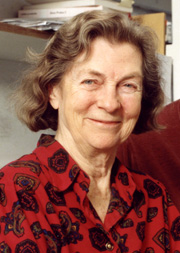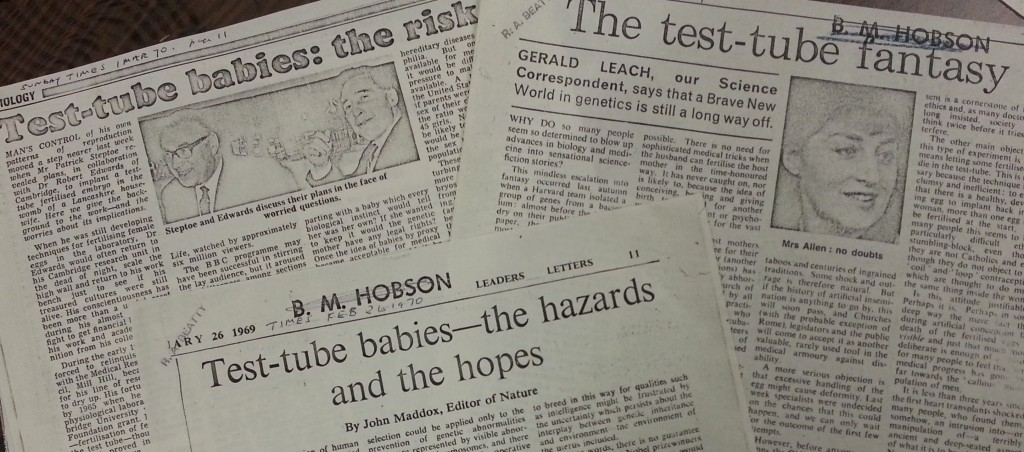It’s always great to receive comments and feedback from our blog readers, especially those which suggest subjects or people which we haven’t yet featured. We have a growing list of posts to respond to our readers’ suggestions, and we are delighted that our first of these focuses on Dame Anne McLaren.
Anne McLaren was a hugely important figure in the fields of mammalian reproductive and developmental biology and genetics, and she is possibly best known for her work as director of the Medical Research Council Mammalian Development Unit at University College London. Her long and rich career in the techniques and ethics of fertility is covered in ample detail in John Biggers’ excellent obituary: http://www.theguardian.com/science/2007/jul/10/uk.obituaries
In this blog, I want to focus specifically on McLaren’s time in Edinburgh, and her appearances in our archive collections. After gaining her degree at Oxford and completing postdoctoral work in London, McLaren moved to Edinburgh in 1959 with her then-husband Donald Michie. She joined the Agricultural Research Council’s Unit of Animal Genetics (based within the Institute of Animal Genetics), working initially on the reproductive physiology of the mouse with Alan Beatty and others. During her time at the Institute, McLaren’s research spanned mammalian fertility, embryo transfer techniques and immunocontraception. She was particularly interested in egg transfer, the hormonal control of ovulation, superovulation and its effects on pregnancy, placental and foetal growth, and the effects of the uterine environment on skeletal character. She and John Biggers were the first to demonstrate that a mammalian embryo grown in vitro for several days would subsequently develop into a normal adult. McLaren also worked with chimeras (organisms consisting of two or more genetically different kinds of tissue), and her later book on the subject, published in 1976, became a classic text.
McLaren was well liked and respected in Edinburgh. The correspondence of Institute of Animal Genetics director C.H. Waddington reveals that he proposed McLaren for Fellowship of the Royal Society in 1968 (he was disappointed that she was not elected until 1974, after she had left the Institute), with F.W. Rogers Brambell as seconder. Waddington’s statement of support commends McLaren’s work on the reproductive biology of the mouse, and in particular the rigour of her statistical and quantitative approach. Waddington also praises her personal attributes: ‘She has in a high degree an ability found only in some scientists of being both highly critical and extremely helpful. Very many workers, at all levels from the young to quite mature ones, like to talk over with her some subject they are tackling, confident that she will spot any weaknesses in their arguments, or, more positively, coax them into thinking straighter than they had done before.’ (Coll-41/9/4/4)
Alan Beatty’s papers contain the most information relating to McLaren, as they worked closely together until McLaren departed for London in 1974. They secured a series of grants from the Ford Foundation for a sustained programme of work on reproductive physiology, and together with colleagues, they lobbied for a Centre for Reproductive Biology to be established in Edinburgh (which occurred in 1980). Beatty’s archive reveals an active and busy schedule of planning meetings and funding applications underpinning he and McLaren’s research. Letters from McLaren after her departure to London show that she continued to take an interest in matters in Edinburgh, and stayed in touch with old colleagues and friends.
In London, McLaren’s research took her on to study the development of mammalian primordial germ cells, and she published an acclaimed book on the subject in 1980. After her retirement from the MGU, she became principal research associate at the Welcome Trust/Cancer Research UK Gurdon Institute in Cambridge. Anne McLaren died aged 80, along with her former husband Donald Michie, in a car accident en route from Cambridge to London on 7 July 2007.
Importantly, McLaren’s scientific work formed the basis of her wider engagement with ethical and societal issues surrounding fertility and reproduction, and, later, stem cell research and cloning technologies. She sat on the Warnock Committee, which contributed to the passing of the 1987 Family Law Reform Act and the 1990 Human Fertilisation and Embryology Act. A copy of one of her articles, titled ‘The Future of the Family’, was retained by Waddington in his papers, and demonstrates that, for McLaren, science has the potential to direct humans towards a better society. The article, written in 1972, concludes:
People in the future will be faced with more leisure: I hope that they will use it for a greater degree of democratic participation in the running of our society; for self-education, aided by computers whose tutorial intelligences will soon be at our disposal; and above all for the benefit of their smaller families of children. It is in the early years of life that personalities are moulded and the foundations of ethical systems laid: we must find out how not to cripple children’s minds as most, perhaps all, are crippled today, and how to instil an ethic of loyalty and protectiveness which begins with other members of the family and does not stop at national boundaries, but extends for the first time over the entire human race.
Clare Button
Project Archivist
If you have a topic relating to animal genetics in Edinburgh which you’d like to see covered, get in touch!


